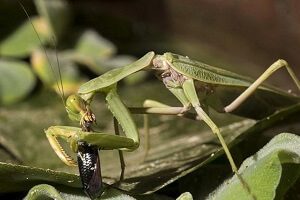Although any man and his dog will have a story about these really popular insects, there are very few people that actually know what Praying Mantises eat. If you’re planning to get one as a pet, then this information will be very important. This article will give you a clearer understanding of the diet of a praying mantis.
An interesting fact about praying mantises is that they will skip over the normal larvae stage of insects. Also, they have a rather long lifespan, which is around 12 years, a lot longer than most other insects have. As I already said in a previous article, their name actually comes from the way in which they keep their front legs, almost as if they are praying. This is very unusual for an insect.
You will usually see praying mantises active during the daytime, which makes them diurnal in nature. They will hunt the prey using their spiked forelegs, which are specifically designed for a better range of movement. Another impressive adaptation that offers mantises an edge over their prey is their ability to rotate their head at a 300° angle. Scientists were able to map over 2000 species of mantis all around the world, mostly in temperate and tropical regions. The diversity found inside this species also means diversity in the food they like to consume.
You might also like my articles on the lifecycle of praying mantises, the lifecycle of mealworms, and the anatomy of a cricket.
But what do Praying Mantises actually Eat?
 The praying mantis is considered a strictly carnivorous insect by nature. Their usual diet will often be comprised of a combination of dragonflies, bees, roaches, spiders, moths, butterflies, beetles, grasshoppers, flies, mosquitoes, and other insects. They won’t eat just insects and will have the occasional birds, rodents, frogs, and lizards. Although all species of mantis will eat insects, only some can actually go for bigger creatures like rodents or birds, and these are usually the ones that can grow up beyond 10 cm in size. In regions where praying mantises meet hummingbirds, it is not all that uncommon for the large insect to eat this bird. Their amazing camouflage abilities aren’t used only to confuse predators, but will also help in hunting their prey. They will wait for the victim to get within their grabbing range and then they will attack with huge speed, using their flexible legs to catch and hold it.
The praying mantis is considered a strictly carnivorous insect by nature. Their usual diet will often be comprised of a combination of dragonflies, bees, roaches, spiders, moths, butterflies, beetles, grasshoppers, flies, mosquitoes, and other insects. They won’t eat just insects and will have the occasional birds, rodents, frogs, and lizards. Although all species of mantis will eat insects, only some can actually go for bigger creatures like rodents or birds, and these are usually the ones that can grow up beyond 10 cm in size. In regions where praying mantises meet hummingbirds, it is not all that uncommon for the large insect to eat this bird. Their amazing camouflage abilities aren’t used only to confuse predators, but will also help in hunting their prey. They will wait for the victim to get within their grabbing range and then they will attack with huge speed, using their flexible legs to catch and hold it.
Praying Mantises as a Pets
People in all parts of the world own mantises as pets, due to their overall docile nature. If you want to own this insect as a pet, then you should try to keep its diet as close to what it would eat in the wild as possible, to ensure that it will get all of the nutrients it needs to develop properly and stay healthy. And feeding a praying mantis in captivity isn’t all that hard after all, because you will usually find an abundance of insects all around your home, especially during the warmer seasons. A pet mantis will surely love to eat mosquitoes and flies a lot. If you get the mantis while it is still very young, keep in mind that you should give it prey that is smaller than it in size and gradually increase the size of the insects as the pet grows. A great way to start is with fruit flies, especially for very small praying mantises.
Conclusion
This article should be enough for you to get an idea of what praying mantises like to eat. Keep in mind that along with its diet, there are a few other things you will have to consider before getting one as a pet. A very important aspect will also be the tank you store the insect in. But I will probably make a different article about this at some point. If you have any other questions about praying mantises, leave a comment in the form below and I`ll answer as soon as possible, either in a different article or in a private message.




